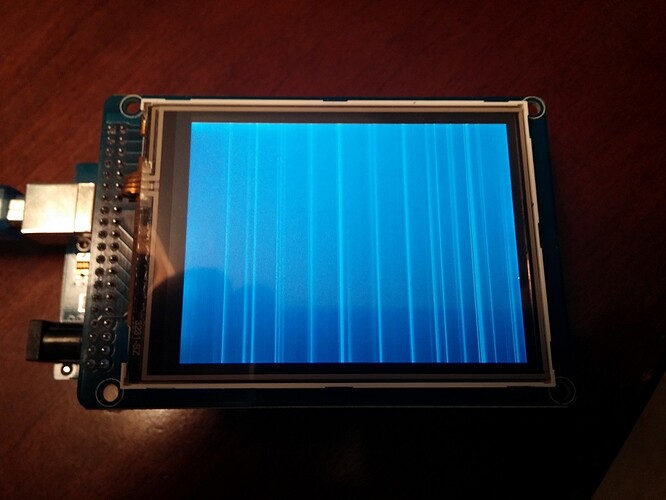I am attempting to connect a 3.2 TFT LCD to a Mega 2560-r3 through itead ITDB02v1.1 shield.
The LCD and mega are both cheap Chinese models.
Board - http://www.gearbest.com/development-boards/pp_18651.html
Shield - http://imall.iteadstudio.com/prototyping/kits/im120717001.html
I have been able to get the screen to display every sketch I try, but the display is not acknowledging any touch input.
I am trying to use the UTFT and UTouch libraries.
I am not able to draw in either the quick draw or quick paint sketches, nor am I able to calibrate or press any buttons in those sketches.
I contacted the seller to see if they had any code I could test, and the only answer I got was to try Googleing the problem...wow why didnt I think of that?!?! :![]()
I havent been able to find much for others with the similar problem with this setup. That along with >2000 of these screens being sold by the vendor makes me think I may have a non functioning unit.
Any help would be greatly appreciated.
Thanks
Ryan
// UTouch_QuickPaint (C)2013-2014 Henning Karlsen
// web: http://www.henningkarlsen.com/electronics
//
// This program is a quick demo of how to use the library.
//
// This program requires the UTFT library and a display
// module with at least 320x240 pixels resolution.
//
// It is assumed that the display module is connected to an
// appropriate shield or that you know how to change the pin
// numbers in the setup.
//
#include <UTFT.h>
#include <UTouch.h>
// Initialize display
// ------------------
// Set the pins to the correct ones for your development board
// -----------------------------------------------------------
// Standard Arduino Uno/2009 Shield : <display model>,19,18,17,16
// Standard Arduino Mega/Due shield : <display model>,38,39,40,41
// CTE TFT LCD/SD Shield for Arduino Due : <display model>,25,26,27,28
// Teensy 3.x TFT Test Board : <display model>,23,22, 3, 4
// ElecHouse TFT LCD/SD Shield for Arduino Due : <display model>,22,23,31,33
//
// Remember to change the model parameter to suit your display module!
UTFT myGLCD(ITDB32S,38,39,40,41);
// Initialize touchscreen
// ----------------------
// Set the pins to the correct ones for your development board
// -----------------------------------------------------------
// Standard Arduino Uno/2009 Shield : 15,10,14, 9, 8
// Standard Arduino Mega/Due shield : 6, 5, 4, 3, 2
// CTE TFT LCD/SD Shield for Arduino Due : 6, 5, 4, 3, 2
// Teensy 3.x TFT Test Board : 26,31,27,28,29
// ElecHouse TFT LCD/SD Shield for Arduino Due : 25,26,27,29,30
//
UTouch myTouch( 6, 5, 4, 3, 2);
// Declare which fonts we will be using
extern uint8_t BigFont[];
int color = 0;
word colorlist[] = {VGA_WHITE, VGA_BLACK, VGA_RED, VGA_BLUE, VGA_GREEN, VGA_FUCHSIA, VGA_YELLOW, VGA_AQUA};
int bsize = 4;
void drawColorMarkerAndBrushSize(int col)
{
myGLCD.setColor(VGA_BLACK);
myGLCD.fillRect(25, 0, 31, 239);
myGLCD.fillRect(myGLCD.getDisplayXSize()-31, 161, myGLCD.getDisplayXSize()-1, 191);
myGLCD.setColor(VGA_WHITE);
myGLCD.drawPixel(25, (col*30)+15);
for (int i=1; i<7; i++)
myGLCD.drawLine(25+i, ((col*30)+15)-i, 25+i, ((col*30)+15)+i);
if (color==1)
myGLCD.setColor(VGA_WHITE);
else
myGLCD.setColor(colorlist[col]);
if (bsize==1)
myGLCD.drawPixel(myGLCD.getDisplayXSize()-15, 177);
else
myGLCD.fillCircle(myGLCD.getDisplayXSize()-15, 177, bsize);
myGLCD.setColor(colorlist[col]);
}
void setup()
{
myGLCD.InitLCD();
myGLCD.clrScr();
myGLCD.setFont(BigFont);
myTouch.InitTouch();
myTouch.setPrecision(PREC_HI);
myGLCD.setColor(VGA_WHITE);
myGLCD.drawLine(32,0,32,myGLCD.getDisplayYSize()-1);
myGLCD.drawLine(myGLCD.getDisplayXSize()-32,0,myGLCD.getDisplayXSize()-32,myGLCD.getDisplayYSize()-1);
myGLCD.print("C", myGLCD.getDisplayXSize()-24, 8);
myGLCD.print("L", myGLCD.getDisplayXSize()-24, 24);
myGLCD.print("E", myGLCD.getDisplayXSize()-24, 40);
myGLCD.print("A", myGLCD.getDisplayXSize()-24, 56);
myGLCD.print("R", myGLCD.getDisplayXSize()-24, 72);
myGLCD.print("+", myGLCD.getDisplayXSize()-24, 136);
myGLCD.print("-", myGLCD.getDisplayXSize()-24, 200);
myGLCD.fillRect(myGLCD.getDisplayXSize()-32,96,myGLCD.getDisplayXSize()-1,128);
myGLCD.drawLine(myGLCD.getDisplayXSize()-32,160,myGLCD.getDisplayXSize()-1,160);
myGLCD.drawLine(myGLCD.getDisplayXSize()-32,192,myGLCD.getDisplayXSize()-1,192);
myGLCD.drawLine(myGLCD.getDisplayXSize()-32,224,myGLCD.getDisplayXSize()-1,224);
for (int i=0; i<8; i++)
{
myGLCD.setColor(colorlist[i]);
myGLCD.fillRect(0, (i*30), 24, (((i+1)*30)-1));
}
drawColorMarkerAndBrushSize(color);
}
void loop()
{
long x, y;
while (myTouch.dataAvailable() == true)
{
myTouch.read();
x = myTouch.getX();
y = myTouch.getY();
if ((x!=-1) and (y!=-1))
{
if (x>(31+bsize) and (x<myGLCD.getDisplayXSize()-(31+bsize)))
{
if (bsize==1)
myGLCD.drawPixel(x, y);
else
myGLCD.fillCircle(x, y, bsize);
}
else
{
if (x<(30+bsize))
{
if (y<240)
{
color = y / 30;
drawColorMarkerAndBrushSize(color);
while (myTouch.dataAvailable()) {};
delay(50);
}
}
else
{
if (y<96)
{
myGLCD.setColor(VGA_BLACK);
myGLCD.fillRect(33, 0, myGLCD.getDisplayXSize()-33, myGLCD.getDisplayYSize()-1);
myGLCD.setColor(colorlist[color]);
}
if ((y>128) and (y<160))
{
if (bsize<7)
{
bsize++;
drawColorMarkerAndBrushSize(color);
while (myTouch.dataAvailable()) {};
delay(50);
}
}
if ((y>160) and (y<192))
{
bsize=4;
drawColorMarkerAndBrushSize(color);
while (myTouch.dataAvailable()) {};
delay(50);
}
if ((y>192) and (y<224))
{
if (bsize>1)
{
bsize--;
drawColorMarkerAndBrushSize(color);
while (myTouch.dataAvailable()) {};
delay(50);
}
}
}
}
}
}
}



